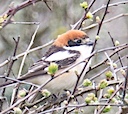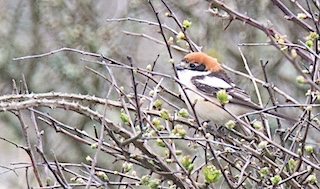 The Woodchat Shrike is a lovely species from further south that is an occasional vagrant to our shores.
The Woodchat Shrike is a lovely species from further south that is an occasional vagrant to our shores.
Photo: Dougy Wright
Scientific name: Lanius senator
Conservation status: IUCN Red List: Least Concern; UK Birds of Conservation Concern, not assessed.
What to look for:
• Colouring and appearance: Males are reddish brown crown and nape and black across the eyes and forehead. The wings are black with a white patch on the primaries. The lower back is grey. The females are duller, with a brown-grey mantle and the black eye-mask showing some buff-white colouration.
• Size: Wingspan 27 cm, length 18 cm.
• Where: The Woodchat Shrike breeds in southern Europe, northern Africa and the Middle East, but is an occasional vagrant to Britain, with a handful of records every year.
• Call: Listen here.
 Sightings of Woodchat Shrikes in Britain are relatively rare – this is a bird that breeds in southern Europe, northern Africa and the Middle East, and overwinters further south in central Africa. Each year, however, from spring to summer, a small handful of vagrants arrive on our shores here in the UK. You can see recent Cornwall records here.
Sightings of Woodchat Shrikes in Britain are relatively rare – this is a bird that breeds in southern Europe, northern Africa and the Middle East, and overwinters further south in central Africa. Each year, however, from spring to summer, a small handful of vagrants arrive on our shores here in the UK. You can see recent Cornwall records here.
The Woodchat Shrike’s breeding habitat encompasses forest edges and glades, where it feeds on invertebrates, especially beetles. It hunts from a perch and, in common with other shrikes, spears its killed prey on thorns, creating a “larder”. The genus name Lanius is, for obvious reasons, from the Latin word for butcher.
Did you know…?
…The common name shrike has its roots in the Old English word scríc, meaning shriek, echoing the shrill call of this and others of the shrike family.
More information and references:
Svensson, L., Mullarney, K., Zetterstrom, D.,1986. Collins Bird Guide, second edition (translated by Christie, D., Svensson, L.). HarperCollins, London.
Published: April 2017
Author: Amanda Scott
Photos: Dougy Wright
